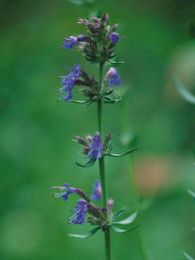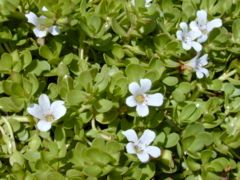|

Hyssop |
The cultivated Hyssop, now of frequent occurrence in the herb-bed, and a favorite plant there because of its fragrance, belongs to the labiate order, and possesses cordial qualities which give it rank as a Simple. It has pleasantly odorous striped leaves which vary in color, and possess a camphoraceous odor, with a warm aromatic bitter taste. This is of comparatively recent introduction into our gardens, not having been cultivated until Gerard's time, about 1568, and not
being a native English herb.
The Ussopos of Dioscorides, was named from azob, a holy herb, because used for cleansing sacred places. Hence it is alluded to in this sense scripturally: "Purge me with Hyssop, and I shall be clean: wash me, and I shall be whiter than snow" (Psalm li. 7). Solomon wrote "of all trees, from the Cedar in Lebanon to the Hyssop that springeth out of the wall." The |
healing virtues of the plant are due to a particular volatile oil which admirably promotes expectoration in bronchial catarrh and asthma. Hyssop tea is a grateful drink well adapted to improve the tone of a feeble stomach, being brewed with the green tops of the herb. The same parts of the plant are sometimes boiled in soup to be given for asthma. The leaves and flowers are of a warm pungent taste, and of an agreeable aromatic smell; therefore if the tops and blossoms are
reduced to a powder and added to cold salad herbs they give a comforting cordial virtue.
There was formerly made a distilled water of Hyssop, which may still be had from some druggists, it being deemed a good pectoral medicine. In America an infusion of the leaves is used externally for the relief of muscular rheumatism, as also for bruises and discolored contusions. The herb was sometimes called Rosemary in the East, and was hung up to afford protection from the evil eye, as well as to guard against witches.
To make Hyssop tea, one drachm of the herb should be infused in a pint of boiling water, and allowed to become cool. Then a wineglassful is to be given as a dose two or three times in the day.
Of the essential oil of Hyssop, from one to two drops should be the dose. Pliny said: "Hyssop mixed with figs, purges; with honey, vomits." If the herb be steeped in boiling water and applied hot to the part, it will quickly remove the blackness consequent upon a bruise or blow, especially in the case of "black" or blood-shot eyes.
Parkinson says that in his day "the golden hyssop was of so pleasant a color that it provoked every gentlewoman to wear them in their heads, and on their arms with as much delight as many fine flowers can give." The leaves are striped conspicuously with white or yellow; for which reason, and because of their fragrance, the herb is often chosen to be planted on graves. The green herb, bruised and applied, will heal cuts promptly. Its tea will assist in promoting the monthly
courses for women. Hyssop grows wild in middle and southern Europe.
|

Water Hyssop |
The Hedge Hyssop (Gratiola officinalis), or Water Hyssop, is quite a different plant from the garden pot-herb, and belongs to the scrofula-curing order, with far more active medicinal properties than the Hyssop proper. The commonly recognized Hedge Hyssop bears a pale yellow, or a pale purple flower, like that of the Foxglove; and the whole plant has a very bitter taste. A medicinal tincture (H.) is made
from the entire herb, of which from eight to ten drops may be taken with a tablespoonful of cold water three times in the day. It will afford relief against nervous weakness and shakiness, such as occur after an excessive use of coffee or tobacco. The title "gratiola," is |
from dei grati "by the grace of God."
The juice of the plant purges briskly, and may be usefully employed in some forms of dropsy. Its decoction is milder of action, and proves beneficial in cases of jaundice. In France the plant is cultivated as a perfume, and it is said to be an active ingredient in the famous Eau mcinale for gout.
Of the dried leaves from five to twenty-five grains will act as a drastic vermifuge to expel worms. The root resembles ipecacuanha in its effects, and in moderate quantities, as a powder or decoction, helps to stay bloody fluxes and purgings. The flowers are sometimes of a blood-red hue, and the whole plant contains a special essential oil.
"Whoso taketh," says Parkinson, "but one scruple of "Gratiola" (Hedge Hyssop) bruised, shall perceive evidently his effectual operation and virtue in purging mightily, and that in great abundance, watery, gross, and slimy tumors." Caveat qui sumpserit. On the principle of affinities, small diluted doses of the tincture, or decoction, or of the dried leaves, prove curative in cases of fluxes from the lower bowels, where irritation within the fundament is frequent, and
where there is considerable nervous exhaustion, especially in chronic cases of this sort.
Herb Simples
The Primitive Simplers presented here show the way of life in other generations, it is not suggested or recommended trying them yourself. |
|
Garden
Herbs
Home
History of Herbs
Herb Gardening
Herbs for Beginners
Drying & Preserving Herbs
Indoor Herb Gardening
Herb Garden
Hints & Tips
Herbal
Cooking
Herb Chart
Using Herbs
Culinary Herbs
Herb
Oil and Vinegar
Herb Teas
Herb Candy
Herb Jelly
Herb Simples
Preface
Introduction
Alphabetical Listing

Trade
Recipes Online
Share your Recipes with others!!
|



